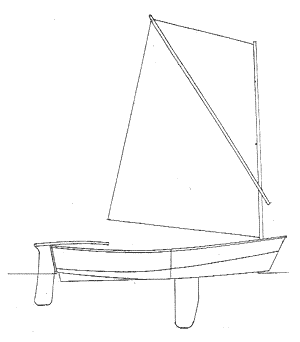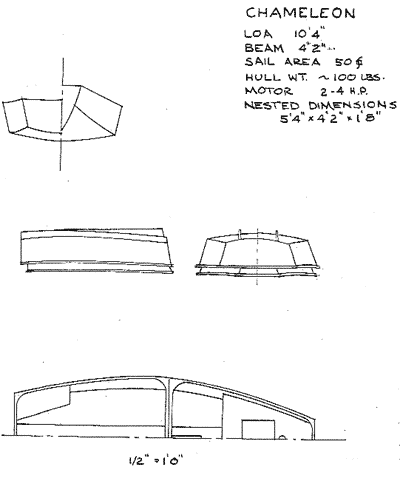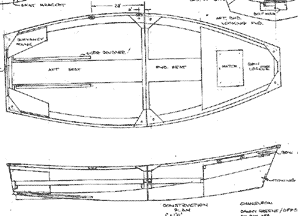I have been designing and buliding nesting dinghies for more
than ten years. The priinary reason that I have been concentratng
on this type of boat is that I have, at the same time, been living
aboard. and cruising on small sailboats.
In 1977 I cruised to the Caribbean on my 28 foot cutter, FROLIC,
and carried an inflatable dinghy and an outboard motor. First
I tired of the noise, mess, smell and expense of the outboard
motor; then I tired of the uselessness of the inflatable as a
rowboat (not to mention it's vulnerabllity to damage and theft).
In 1979 I designed and built TWO BITS, a two-piece nesting dinghy
built of plywood and epoxy resin, using the "stitch and tape"
construction technique.

TWO BITS was about 9-1/2 feet long, 4 feet wide, and stowed in
five feet of length. She served me well, and I sold hundreds of
sets of plans for her. Over the years, I experimented with various
other dimensions, hull shapes and construction details. I tried
boats up to 16 feet in length and with two and three nesting pieces.
Some towed beautifully, some sailed very well, some towed well,
some were stable, some handled rough weather easily, some were
light and compact to stow and some were very easy to build. None,
however, combined these qualities in a way that satisfied me,
until CHAMELEON.
Surely there are small boats that can outperform her in one or
two areas, but I do not know of any that have these same all-round
performance characteristics that make CHAMELEON an ideal tender
for a cruising boat. She is , as well, a very attractive multi-purpose
boat that can be easily transported by one or two people and stowed
in a very small place.
CHAMELEON's two poeces can be assembled and disassembled in the
water, so it is possible to launch and retrieve her one piece
at a time. Each piece weighs approximately 50 pounds. There are
built-in buoyancy chambers in the stern quarters and a foredeck
locker that could be left sealed for buoyancy, fitted with a watertight
hatch, or fitted with a "water-resistant" plywood hatch.
As a rowboat, CHAMELEON features two rowing positions, so she
can be proberly trimmed with one, two, or three people aboard.
Oars of about 7-1/2 feet length seem to work best. Save capacity
is about 500 pounds. For those interested in fitness rowing I
have designed a sliding seat/outrigger option that is inexpensively
built of plywood and allows use of 8-1/2 to 9 foot oars.

CHAMELEON is built in the "stitch and glue" plywood/epoxy
technique. The plywood panels are cut out from dimensions provided
in the building plans (or from full sized patterns) and fastened
together using copper wire and nylon fishing line. There is no
strongback or building jig required; the hull is both self-supporting
and movable during construction. Thus it can be worked on outdoors
if desired, and moved inside (or covered with a tarp) at night
or in inclememt weather.
After the panels are assembled into the hull shape, a thickened
epoxy fillet is applied to all the inside corners, followed by
two layers of figerglass cloth tape and epoxy resin. The the outside
corners are rounded and taped. Next the entire outside is sheathed
in cloth and epoxy and the other constuction details are completed.
Though CHAMELEON is intended for the amateur builder, she is
not an extremely easy boat to build. The number of details involved
in making the two-piece nesting dinghy make it nearly as much
work as building two dinghies. Some previous boatbuilding experience,
or some previous experience working with epoxy resin, would certainly
be an asset. Yet, I think that a very handy builder, with some
assistance (in the form of an experienced friend or some reverence
material on "stitch and glue" construction) could successfully
build CHAMELEON.
Tools required to build the design include a table saw (or access
to a table saw), electric faber saw, electric grinder, drill,
hand saw, wire cutters, pliers, hammer, screwdriver and about
six clamps (3" or 4"). The basic materials for the towing
version are 3 sheets of 1/4" exterior (or marine) plywood,
three gallons of epoxy resin, figerglass tape and cloth, and two
fairly clear spruce 2x4's, 12 feet long. The sailing version requires
one additional sheet of 1/4" plywood, another gallon of epoxy
resin, and two more 12 foot spruce 2x4's.

click to enlarge
Costs and building time will certainly vary with the skills of
the builder and the sources of materials. I would estimate the
time and cost of building the rowing version of CHAMELEON at 80
to 100 hours, and $500 to $600. The sailing version would require
and additional 30 to 40 hours and approximately $150 to $250.
Building plans and instructions are available for $35 from:
Danny Greene
Offshore Designs Ltd.
PO Box GE 213
St George's
Bermuda GE BX
Full sized patterns for the hull panels are
$15 extra.

|

